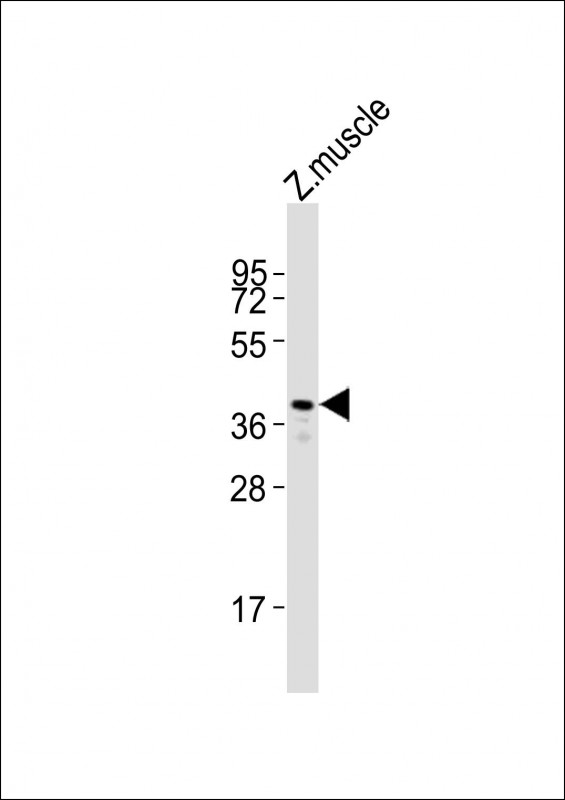Zebrafish rho Antibody (N-Term)
Purified Rabbit Polyclonal Antibody (Pab)
- SPECIFICATION
- CITATIONS
- PROTOCOLS
- BACKGROUND

Application
| WB, E |
|---|---|
| Primary Accession | P35359 |
| Reactivity | Zebrafish |
| Host | Rabbit |
| Clonality | polyclonal |
| Isotype | Rabbit IgG |
| Calculated MW | 39706 Da |
| Antigen Region | 62-93 aa |
| Gene ID | 30295 |
|---|---|
| Other Names | Rhodopsin, rho, zfo2 |
| Target/Specificity | This Zebrafish rho antibody is generated from a rabbit immunized with a KLH conjugated synthetic peptide between 62-93 amino acids from zebrafish rho. |
| Dilution | WB~~1:2000 E~~Use at an assay dependent concentration. |
| Format | Purified polyclonal antibody supplied in PBS with 0.09% (W/V) sodium azide. This antibody is purified through a protein A column, followed by peptide affinity purification. |
| Storage | Maintain refrigerated at 2-8°C for up to 2 weeks. For long term storage store at -20°C in small aliquots to prevent freeze-thaw cycles. |
| Precautions | Zebrafish rho Antibody (N-Term) is for research use only and not for use in diagnostic or therapeutic procedures. |
| Name | rho |
|---|---|
| Synonyms | zfo2 |
| Function | Photoreceptor required for image-forming vision at low light intensity. While most salt water fish species use retinal as chromophore, most freshwater fish use 3-dehydroretinal, or a mixture of retinal and 3-dehydroretinal (By similarity). Light-induced isomerization of 11-cis to all-trans retinal triggers a conformational change that activates signaling via G-proteins. Subsequent receptor phosphorylation mediates displacement of the bound G-protein alpha subunit by arrestin and terminates signaling (By similarity). |
| Cellular Location | Membrane {ECO:0000250|UniProtKB:P08100}; Multi- pass membrane protein {ECO:0000250|UniProtKB:P08100}. Cell projection, cilium, photoreceptor outer segment Note=Synthesized in the inner segment (IS) of rod photoreceptor cells before vectorial transport to disk membranes in the rod outer segment (OS) photosensory cilia. {ECO:0000250|UniProtKB:P08100} |
| Tissue Location | Retinal rod photoreceptor cells, predominantly in the outer segments (at protein level) (PubMed:10349976). Retinal rod photoreceptor cells (PubMed:8327475, PubMed:8603882) |

Thousands of laboratories across the world have published research that depended on the performance of antibodies from Abcepta to advance their research. Check out links to articles that cite our products in major peer-reviewed journals, organized by research category.
info@abcepta.com, and receive a free "I Love Antibodies" mug.
Provided below are standard protocols that you may find useful for product applications.
Background
Visual pigments such as rhodopsin and porphyropsin are light-absorbing molecules that mediate vision. Rhodopsin consists of an apoprotein, opsin, covalently linked to 11-cis-retinal. This receptor is coupled to the activation of phospholipase C. Porphyropsin consists of opsin covalently linked to 11-cis 3,4- didehydroretinal.
References
Robinson J.,et al.Proc. Natl. Acad. Sci. U.S.A. 90:6009-6012(1993).
Robinson J.,et al.Vis. Neurosci. 12:895-906(1995).
Schmitt E.A.,et al.Vis. Neurosci. 16:601-605(1999).
Vihtelic T.S.,et al.Vis. Neurosci. 16:571-585(1999).
Kennedy B.N.,et al.J. Biol. Chem. 276:14037-14043(2001).
If you have used an Abcepta product and would like to share how it has performed, please click on the "Submit Review" button and provide the requested information. Our staff will examine and post your review and contact you if needed.
If you have any additional inquiries please email technical services at tech@abcepta.com.













 Foundational characteristics of cancer include proliferation, angiogenesis, migration, evasion of apoptosis, and cellular immortality. Find key markers for these cellular processes and antibodies to detect them.
Foundational characteristics of cancer include proliferation, angiogenesis, migration, evasion of apoptosis, and cellular immortality. Find key markers for these cellular processes and antibodies to detect them. The SUMOplot™ Analysis Program predicts and scores sumoylation sites in your protein. SUMOylation is a post-translational modification involved in various cellular processes, such as nuclear-cytosolic transport, transcriptional regulation, apoptosis, protein stability, response to stress, and progression through the cell cycle.
The SUMOplot™ Analysis Program predicts and scores sumoylation sites in your protein. SUMOylation is a post-translational modification involved in various cellular processes, such as nuclear-cytosolic transport, transcriptional regulation, apoptosis, protein stability, response to stress, and progression through the cell cycle. The Autophagy Receptor Motif Plotter predicts and scores autophagy receptor binding sites in your protein. Identifying proteins connected to this pathway is critical to understanding the role of autophagy in physiological as well as pathological processes such as development, differentiation, neurodegenerative diseases, stress, infection, and cancer.
The Autophagy Receptor Motif Plotter predicts and scores autophagy receptor binding sites in your protein. Identifying proteins connected to this pathway is critical to understanding the role of autophagy in physiological as well as pathological processes such as development, differentiation, neurodegenerative diseases, stress, infection, and cancer.


